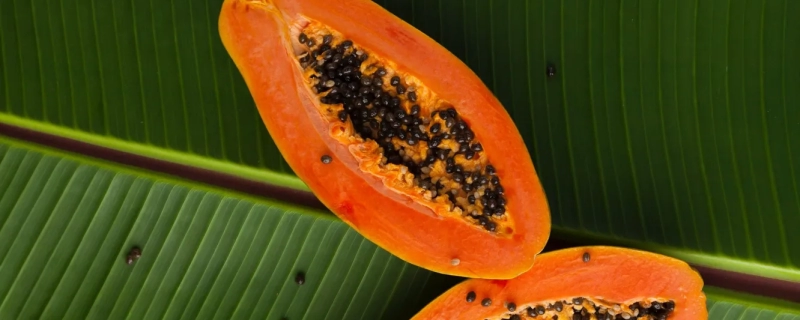Papaya: Taste Profile, Aroma, Benefits and Health Risks
Papaya, a tropical fruit native to Central and South America, is known for its vibrant orange flesh and unique, musky-sweet flavor. It’s widely enjoyed fresh, in salads, or blended into smoothies, and is valued for its nutritional content, particularly in vitamins A and C. Papaya’s distinct flavor and tender texture make it a popular choice in tropical and fusion cuisine.
What does Papaya taste like?

Primary Flavor Characteristics
Papaya has a mild, musky sweetness with subtle floral notes. Its flavor can be polarizing; while some people enjoy its creamy, melon-like taste, others find the muskiness overwhelming. The ripeness of the fruit significantly impacts its taste, with ripe papaya offering a sweet, tropical flavor, and unripe papaya being almost flavorless or slightly bitter.
Aromatic and Taste Nuances
The aroma of papaya is tropical and fruity with a hint of musk. Its taste is often described as a combination of melon and peach, with a slightly earthy undertone. Ripe papaya has a smooth, almost buttery texture, adding to its appeal as a fresh fruit snack.
Scientific Description of Taste and Aroma
- Aroma: Tropical, fruity, and mildly musky.
- Taste: Sweet, with hints of melon and slight musky undertones.
- Texture: Soft, smooth, and buttery when ripe; firmer when unripe.
In-Depth Flavor Analysis of Papaya
Underlying Flavor Notes
Papaya has a unique flavor profile with layered notes:
- Musky Sweetness: The mild, sweet taste has an underlying muskiness, adding complexity to its flavor.
- Melon-Like Softness: The taste resembles cantaloupe or honeydew, making it familiar to those who enjoy melons.
- Tropical Fruity Undertones: A subtle tropical flavor adds to its exotic appeal.
- Slight Earthiness: A faint earthy quality, especially in less ripe papaya, balances its sweetness.
Impact of Ripeness on Flavor
- Unripe Papaya: Crisp texture, with little flavor; often used in savory dishes.
- Ripe Papaya: Soft and creamy, with a sweet, tropical taste ideal for fresh eating.
- Overripe Papaya: Intensely sweet and slightly mushy, best used in smoothies or desserts.
Textural Qualities
Papaya has a smooth, creamy texture when fully ripe, making it ideal for blending or eating fresh. Unripe papaya is firmer and more suitable for shredding or using in salads.
Culinary Uses of Papaya
Primary Uses
- Fresh Eating: Ripe papaya is often eaten fresh, either on its own or with a squeeze of lime to enhance its flavor.
- Smoothies and Juices: Papaya adds a tropical, creamy texture to smoothies and juices, blending well with other fruits.
- Salads and Salsas: Unripe green papaya is shredded for salads or salsas, adding a mild, crunchy texture.
- Desserts: Ripe papaya is used in fruit salads, parfaits, or tropical desserts for its sweet, delicate flavor.
- Marinades and Sauces: Papaya contains an enzyme called papain, which helps tenderize meat, making it a useful ingredient in marinades.
Ideal Pairings for Papaya
- Citrus Fruits: Lime and lemon add acidity that complements papaya’s sweetness.
- Mint and Basil: Fresh herbs add brightness to papaya-based dishes, particularly in salads and salsas.
- Coconut and Pineapple: Enhance papaya’s tropical flavor in smoothies and desserts.
- Honey and Agave: Natural sweeteners intensify the fruity, floral notes in papaya.
- Chili and Spices: A sprinkle of chili powder balances the sweetness in papaya, adding a spicy twist.
Health Benefits of Papaya
Key Nutrients and Benefits
- High in Vitamin C and A: Papaya is rich in vitamins C and A, supporting immune health, vision, and skin health.
- Antioxidant-Rich: The antioxidants in papaya, including carotenoids, help protect cells from oxidative stress.
- Digestive Enzyme (Papain): Papaya contains papain, an enzyme that aids in protein digestion, making it beneficial for digestive health.
- Low Calorie and Hydrating: With high water content and low calories, papaya is a refreshing, weight-friendly option.
- Supports Heart Health: The fiber, potassium, and antioxidants in papaya promote cardiovascular health.
Potential Precautions
- Allergic Reactions: People with latex allergies may also react to papaya, as it contains similar proteins.
- Moderation for Sensitive Stomachs: The enzyme papain can be strong on the stomach, so moderate intake is recommended for sensitive individuals.

Tips for Choosing and Storing Papaya
How to Choose Quality Papaya
- Color and Softness: Look for papayas with a yellow to orange skin and slight softness when pressed, indicating ripeness.
- Avoid Blemishes: Choose fruits without deep cuts or blemishes for the best quality.
Storage Recommendations
- At Room Temperature: Allow unripe papayas to ripen at room temperature.
- Refrigeration: Ripe papayas can be stored in the refrigerator for up to a week to maintain freshness.
Fun Facts About Papaya
- Tropical Favorite: Papaya is sometimes called the “fruit of the angels” for its sweet flavor and appealing texture.
- Papain Enzyme: Papain, found in papaya, is widely used as a meat tenderizer and in digestive supplements.
- Popular in Asian Cuisine: Unripe green papaya is commonly used in Southeast Asian salads and savory dishes.











